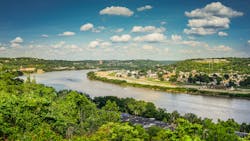A new report, released by the Ohio River Basin Alliance and the National Wildlife Federation, highlights feedback from community listening sessions on restoration priorities for the Ohio River Basin.
The report’s findings stem from 31 community listening sessions held in 2022 and 2023 for residents in the 14-state Ohio River Basin that includes Alabama, Georgia, Illinois, Indiana, Kentucky, Maryland, Mississippi, New York, North Carolina, Ohio, Pennsylvania, Tennessee, Virginia and West Virginia.
The report is available on the National Wildlife Federation and Ohio River Basin Alliance websites.
Input from the sessions is being used to inform the Ohio River Basin Alliance’s plan to restore and protect the waters of the Ohio River Basin. The plan, once complete, will be delivered to the U.S. Congress, with the goal of securing the federal investments to implement the plan’s recommendations.
“A top priority for the Ohio River Basin Alliance is to ensure that the final Ohio River restoration and protection plan is a community-driven document that encompasses the clean water priorities of people in cities and towns across the region,” said Craig Butler, chair of the Ohio River Basin Alliance. “We are listening to communities, taking their comments to heart, and incorporating their ideas into a blueprint to restore these vital waters by supporting solutions that benefit our environment and economy.”
Key findings of the new report, “Community Priorities for Ohio River Basin Restoration and Protection,” include:
- People see drinking water contamination as a top concern, along with flooding.
- People see pollution prevention as essential to prevent new harm to people and communities.
- People see the restoration of local waters tied to the health of local communities and increased quality of life, such as increased access to recreational opportunities.
- People see restoration investments as strong local economic drivers and want workforce development and job training programs so local workers can benefit from restoration actions.
“Residents are dealing with serious threats to their drinking water, health, and well-being—and they want those problems addressed with a sense of urgency,” said Jordan Lubetkin, director of Ohio River Restoration for the National Wildlife Federation. “The onus is now on us to take what we’ve heard in local communities and put forward manageable solutions, so that every person in the region has access to clean, safe and affordable drinking water, healthy communities, and recreational opportunities. The good news is that we have solutions, and it is time to use them, before the problems get worse and more expensive to solve.”
Findings from the report are being incorporated into the Ohio River Basin Alliance’s plan to restore and protect the waters of the 14-state region, which is being written under the leadership of the National Wildlife Federation and Ohio River Valley Water Sanitation Commission.
Every year, the U.S. Congress invests in actions to heal the nation’s great waters, including the Chesapeake Bay, Florida Everglades, and Great Lakes. Ohio River advocates are hoping that the regional restoration plan is a catalyst for increased federal action to address longstanding threats to the region’s water, including sewage contamination, toxic pollution, mine waste, invasive species, runoff pollution, and habitat loss.






